Fall Protection Strategies For Curved Standing Seam Roofs
Posted by Howie Scarboro - CEO Fall Protection Distributors, LLC on Jun 27th 2025

Fall Protection for Curved Standing Seam Roofs: OSHA-Compliant Safety Solutions
Curved metal roofs are beautiful—but they require a safety strategy tailored to the real-world challenges of fall protection.
Architects love that smooth-flowing look, but roofers cringe at the thought of working on a roof with constantly changing pitches and angles. Curved standing seam roofs can be visually stunning, but keeping crews safe while working on those slippery panels isn't something you can solve with a box of standing seam roof anchors and a couple of safety lines. Curved metal roof systems require a fall protection plan that accommodates the radius of the panel.
Please be aware that any penetrations in standing seam panels may void their warranty. That alone disqualifies a huge list of traditional anchors and guardrail systems. Fall protection for curved metal roofing presents additional challenges due to the varying radii of the metal. Manufacturing fall protection to fit every curved roof radius would be cost-prohibitive.
We will examine some of the most popular curved panel options on the market and discuss potential fall protection anchor solutions. The right combination helps ensure a project runs smoothly rather than being shut down due to safety violations.
Popular Curved Panel Systems

Modern architects design some profiles to be curved, fulfilling their creative visions.
Not all standing seam panels can be curved. When it comes to fall protection for curved roofs, the panel you're working on matters. Let's examine five of the more widely recognized curved standing seam systems in the metal roofing industry.
McElroy Metal – Maxima 1.5
McElroy Metal offers several standing seam panels that can be curved to fit specific applications. Let's look at the popular Maxima 1.5. This vertical-leg, mechanically seamed panel can be field-curved to a minimum 12' radius in steel or 10' in aluminum, which opens the door to some dramatic shapes. The 180-degree double-lock seam helps seal out the weather on everything from domed entryways to curved canopies. It comes in 12, 16, and 18-inch widths, using 22-gauge or 24-gauge Galvalume or 0.032 aluminum. For contractors needing a dependable curved solution, this one delivers.
MBCI – BattenLok HS
MBCI's BattenLok HS panel isn't just easy to install—it's also a flexible choice for gently curved designs. With its 2-inch rib height and concealed clips, LokSeam keeps a clean, fastener-free appearance while adapting to low-slope or transitional areas. Available in 12- or 16-inch widths, it's an ideal candidate for designers seeking a modern look without requiring mechanical seaming. This panel is no longer in production, but there are many installations of the BattenLok HS on buildings.
CENTRIA – Curved SRS3
CENTRIA's Curved SRS3 panel has earned plenty of praise from contractors and architects, and for good reason—it's built to curve. The mechanically seamed system supports crimp-free curving, resulting in fewer stress points and more consistent performance on custom builds, such as barrel vaults or low-slope arched structures. With interlocking concealed clips and flexible expansion capabilities, Curved SRS3 panels maintain a weathertight seal while accommodating curved steel framing. They're typically made from 20, 22, or 24-gauge steel or aluminum and have panel widths of 12, 16, and 18-inch. This panel system is a popular choice for architects when designing civic centers or university buildings.
PAC-CLAD (Petersen) – Pac-150 90 Seam
Petersen's Pac-150 panel from the PAC-CLAD line is a favorite among contractors working on longer spans and gentle curves. This 1.5-inch-tall, mechanically seamed panel is available in aluminum or 24-gauge steel. The factory or on-site crews can curve seam widths of 12, 16, 18, or 20 inches down to a 20-foot radius. With floating concealed clips and the ability to handle pitches as low as 1:12, it's a solid performer for industrial projects and arched roofing sections.
Englert – Series C1300 (Pictured Above)
Englert's Series C1300 panel provides a user-friendly option for jobs that require gentle curves but don't necessitate a mechanical seam. This panel series is for use on residential or light commercial projects. With 1-inch or 1.5-inch seam height and mechanical lock design, this panel handles arched canopies and walkways with ease—especially on smaller-scale projects. These panels have widths ranging from 12 to 20 inches and are 24- or 26-gauge steel, copper, zinc, or 0.032-inch aluminum. They install quickly with concealed fasteners. The in-house color selection is extensive, featuring 28 ULTRA-Cool finishes that match almost any project aesthetic.
Every curved panel has unique requirements that affect your choice of fall protection.
As you can see, there is a wide range of curved standing seam options with various design elements, radii, seam heights, panel widths, and panel materials to choose from. Lighter panel materials and batten covers typically prevent the use of seam-mounted fall protection anchors. The curvature of the seams is also an issue when it comes to mounting equipment. All of these variables are critical in determining the most effective and compatible fall protection equipment to include in your safety plan.
Our recommendation is to always consult with a trained safety expert to review the plans or walk the project BEFORE determining the best course of action to take. A trained safety expert should inspect seams to assess their compatibility with clamp-style anchors. Additionally, curved panels often preclude the use of permanent horizontal lifelines or standard guardrail setups.
This situation is where a professional fall protection evaluation becomes essential—before the job begins. An expert will identify OSHA requirements based on your task type—whether it's covered under 1910.29 for general industry or 1926.502 for construction. Without that evaluation, you're flying blind.
Potential Fall Protection Equipment For Curved Roofs
For curved standing seam roofs, OSHA-compliant systems must protect both the worker and the roof.
Now that we have discussed the curved roof systems and the associated safety challenges, let's explore potential solutions to address these concerns. There is no off-the-shelf fall protection system specifically designed for use on curved roof systems. This complication is generally due to the inconsistencies in the curved roof systems that we discussed above. There are too many variables with seam shape and height, roof substrate, panel widths, and materials. If the curved panels meet a parapet wall, then a parapet anchor would be an excellent alternative tie-off point. Installers can place numerous products at the panel termination point if it ends at a ridge cap.
When other options are not available, it's time to get creative. Therefore, we must carefully consider products and techniques that could provide safe anchorage for curved roof systems. The following products and strategies may or may not work in all situations. A highly trained safety expert must approve and supervise the implementation of any of the following products or strategies.
Weighted Carts and Counterweight Anchors
There are numerous counterweight sleds on the market. Manufacturers design some specifically for rooftop use, while others are for ground use. This type of anchor has several variations, including mobile carts, stationary assemblies that break down into numerous individual weights, and inflatable water bladders. In the case of ground-level carts, contractors have used mobile, weighted carts on the ground with ropes attached to the anchor points. The lifelines then extend over the peak of the curved roofs and down the slope to protect the workers on the other side of the peak.
Read the literature carefully to determine suitability for your project. Position the anchors correctly and verify that the roof material and structure can support the added load before placing them on the roof. The first issue that comes to mind with this type of strategy is the potential abrasion of the ropes as they pass over the roof peak. Safety managers must protect the lines from sharp metal edges to prevent fraying and breakage. In this situation, you can use rope guards and padded ridge protectors to mitigate the risk of a rope failure. Refer to OSHA 1925.502(d)(15), "Workers must protect lifelines from cuts and abrasions." Consider routing lifelines in a way that avoids sharp edges and corners. It would be wise to thoroughly inspect all ropes before and after use on metal roofs. Although leading-edge steel cable retractors offer benefits for metal roofs, using them when the metal cable touches the panels can cause serious damage to the finish.
A rooftop version of a counterweight anchor is the Frontline CO2NN Counterweight Anchor. It features a swivel d-ring in the center, surrounded by individual weights. A forklift or crane can lift this 806 lb device to the roof, where one worker can use it for fall arrest or restraint. It is compatible with roofs with a pitch of up to 5 degrees.

Another potential solution is the Frontline EcoAnchor. This simple, portable bladder fills with water in 10 minutes. It is suitable for a single worker in a fall arrest situation or as an anchor point for a horizontal lifeline system. It weighs just 25 lbs when empty. Contractors have used these on curved roofs by placing them on the far side of the curved peak with ropes extending over the peak and down to the workers.
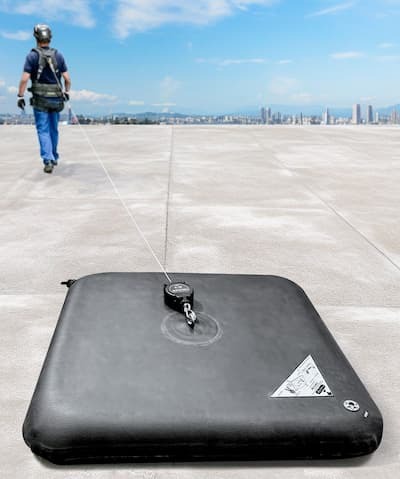
Towable Overhead Anchors
Another style of ground anchor is the towable Malta Dynamics Grabber X1270 device. Malta designed their Grabbers to be towed to the worksite behind regular work vehicles, making them a great solution for contractors with projects at multiple locations. This amazing machine protects up to 2 workers at a maximum working height of 45 feet with overhead anchorage.
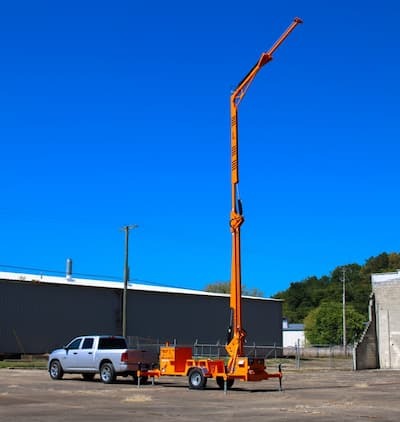
This Malta Grabber is an excellent option for workers having to perform tasks at the edge of metal roofs. Hydraulic controls operate this 6,700 lb machine. The Grabbers are available for custom order, offering a list of options to tailor them to meet the contractor's specific needs. Be sure to check working clearances on towable equipment to ensure they can get close enough to the structure to be effective.
Articulated Boom Cranes
Articulated boom cranes are remarkable machines that provide access to many areas that would normally be inaccessible or unsafe to reach. A PFAS is still required when working from boom lifts to protect the worker from falls and basket ejection. OSHA provides guidance in Subpart CC of 29 CFR 1926, specifically on Cranes and Derricks in Construction. The fall protection requirements for cranes are in 1926.1423.
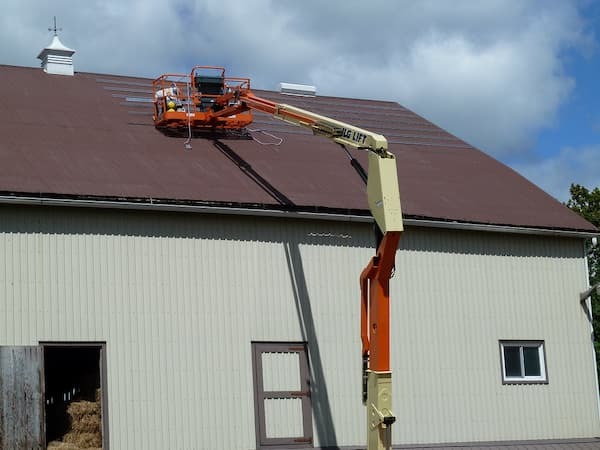
Use a personal fall arrest system (PFAS) when working 6 feet or more above a lower level. Ensure each anchor point supports at least 5,000 pounds and includes a safety factor of 2. The anchorage point on the crane must be able to withstand twice the maximum load imposed by the worker. Full-body harnesses are now required; body belts are no longer acceptable. Depending on the type of work needed, this type of access can be beneficial but may not be feasible for large-scale projects.
Perimeter Protection
For perimeter protection, the 75-foot Frontline GUS75 Guardrail Kit is a weighted, free-standing mounting system that works with the Frontline Guardrail system to create a non-penetrating containment rail for workers. High-strength ASTM steel rails and counterweight bases are strong enough for permanent installs but flexible enough to be used temporarily without harming the panels.
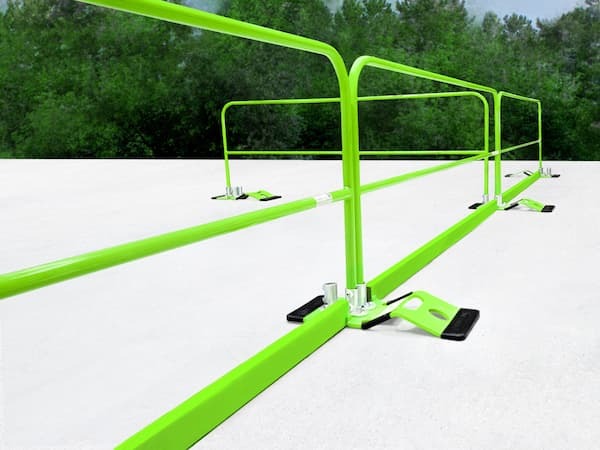
Guardrails must meet the strict standards outlined in Section 1926.502(b) of the OSHA regulations. Top rails should land between 39" and 45" high and hold a 200 lb. outward force. Active systems require more than just gear—they need trained users who know how to install, inspect, and prevent creating a fall hazard through poor safety planning. OSHA 1926.503 spells that out clearly.
Alternative Anchorage Solutions
Let's take a moment to discuss some of the more controversial strategies that contractors have employed when facing challenging fall protection issues. All of us have thought about this at one time or another: using a vehicle as a tie-off with the vertical lifelines running up over the peak of the roof. Have thoughts of using a sturdy oak tree as a tie-off point ever crossed your mind? This type of improvised anchorage is more common in rural areas and on residential projects. However, can these tactics be used on commercial jobs that are subject to OSHA oversight? Is there a way to legally use these non-certified anchorage points while preserving liability protection for the contractor?
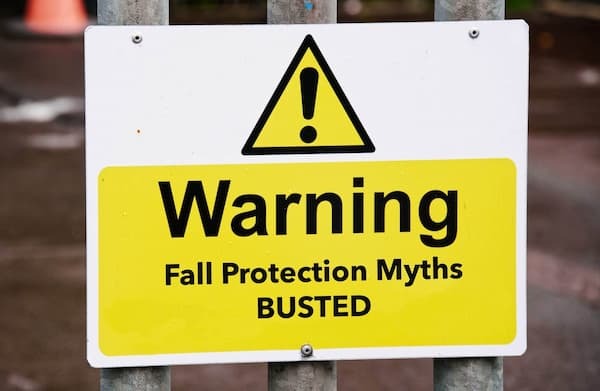
Anchoring to Vehicles
Contrary to popular opinion, OSHA permits fall protection anchorage to vehicles under certain strict conditions. An OSHA-qualified person must make the final decision after reviewing all other options. It is essential to note that an OSHA Qualified Person is a highly trained expert with advanced education and degrees in safety training, exceeding that of an OSHA Competent Person.
The vehicle must be stationary with all controls locked out, keys removed, doors locked, and even the battery disconnected. Operators must set the parking brake to prevent the vehicle from rolling or moving under load. It might be a good idea to park another heavy vehicle in front of the anchor vehicle to help prevent any unintended movement to the anchor vehicle.
The scariest issue with anchoring to vehicles is the nightmare scenario of a vehicle's brakes failing or someone driving it away with a worker attached to the line.
A Qualified Person must supervise the entire Personal Fall Arrest System (PFAS), ensuring the anchor vehicle and all connectors can withstand a 5,000-pound impact per worker. Use this type of anchorage only when no better anchorage solution is available. A Qualified Person will do their best to protect the worker, and at some point, something is better than nothing.
29CFR 1926.502(d)(15) states that Anchorages must be independent and capable of supporting at least 5,000 pounds per attached employee. OSHA has made its opinion very clear on this issue, with multiple Letters of Interpretation reinforcing that vehicles are non-compliant anchors unless they are part of a specifically designed PFAS.
Anchoring to Trees
Let's start by saying that if you thought anchoring to a vehicle was a bad idea, wait until you learn more about anchoring to trees. During one of my Competent Person training classes, the instructor had an excellent method for evaluating trees and other non-certified structures for anchorage. When considering whether to use a structure for a fall protection tie-off, imagine hanging a full-size standard pickup truck weighing approximately 5,000 pounds from it. Would it hold up, would you be nervous, or would it hold the weight easily? Keep that in mind when you determine what can serve safely as a tie-off point.
Trees are unpredictable; they can rot, sway, and fall unexpectedly. Trees are not designed or tested for fall protection and can be completely rotten inside despite appearing perfectly healthy on the outside. Therefore, a complete and thorough inspection is not possible by any level of trained safety expert. If nobody can definitively say that this tree could withstand a 5,000-pound impact, then it cannot be part of the PFAS. Given all these dangers, we should all agree never to attempt this.
However, with most everything in life, there are exceptions. OSHA may permit tree anchorage if a highly trained OSHA-qualified person determines that there is no other alternative and that failing to take some action would further risk injuries or death to the workers. In this case, a Certified Arborist or Structural Engineer should do on-site inspections to help make the determination. OSHA would also want to see a backup or redundancy anchorage in case of failure.
The chances of using a tree for anchorage while maintaining liability protection are incredibly slim. This practice is not advisable under any circumstances except for tree work as prescribed in ANSI Z133.
Since tree anchorage is highly unpredictable, a weighted ground-level cart would be a far better alternative. We all understand that weighted carts come at a high price tag, but playing the cost engineering game with human lives is not advisable. The last place you would ever want to be is a courtroom, under oath, explaining how a worker lost their life because it wasn't in the budget to provide proper fall protection.
Fall Protection for Curved Standing Seam Roofs Requires Expert Planning and Professional Equipment
Curved standing seam roofs challenge everything we know about fall protection using traditional anchors.
Curved standing seam roofs are complex, beautiful, and dangerous to work on without a site-specific fall protection plan. From factory-curved aluminum panels to field-curved Galvalume systems, these roofs eliminate the option of simple, off-the-shelf metal roof anchors.
We've explored some of the most widely used curved panels and reviewed the strategies that may work—from counterweight anchors and rooftop bladder systems to towable overhead lifelines and non-penetrating perimeter guardrails. We also examined risky anchorage options, such as vehicles and trees—and why they rarely meet OSHA standards.
Here's the bottom line: there's no universal solution for fall protection on curved metal roofs. You need a setup that protects both the worker and the roof system itself. Always consult with an OSHA Qualified safety expert before making any decisions. The cost of getting it wrong could be a life—and no roof is worth that risk.
Contact Us For More Information
For further details on roofing solutions and fall protection systems, please contact us at 863-703-4522 or visit www.StandingSeamRoofAnchor.com. Let's work together to make your roofing projects safe, beautiful, and built to last. For more safety tips, refer to OSHA's 48-page Fall Protection Manual.
Safety Tips For Working on Curved Metal Roofing
Prioritize Ladder Safety Training
Ladder-related accidents remain among the most avoidable hazards in the construction industry. Every crew member should be proficient in ladder inspection, proper placement, and secure anchoring using the 4-to-1 rule. Before anyone sets foot on the roof, emphasize safe climbing techniques—like maintaining three points of contact and wearing suitable footwear. Complacency in training can lead to carelessness. Pay attention to the basics.
Equip Workers with High-Quality Safety Gear
Roof safety begins with the proper use of personal protective equipment. OSHA-compliant harnesses, self-retracting lifelines (SRLs), and shock-absorbing lanyards are critical components of a fall arrest system. But it’s not just about checking boxes—gear should be lightweight, comfortable, and easy to use so workers wear it every time. Reliable PPE prevents accidents and builds a culture of trust.
Promote a Culture of Safety
Regulations may enforce compliance, but it's the safety culture that truly protects workers. A strong safety culture begins with leadership and thrives through daily actions, including morning briefings, clear communication, and effective jobsite feedback loops. When every crew member feels empowered to speak up, report hazards, and take ownership, safety becomes second nature—not just a regulation to follow.
Encourage the Use of Trauma Straps
Fall protection doesn't end with the harness. Without trauma straps, a fallen worker can suffer suspension trauma in minutes. These compact straps let workers relieve pressure from leg straps and remain upright while waiting for rescue. They're lightweight, inexpensive, and crucial for survival—making them one of the most overlooked but vital components in a fall arrest kit.
Set Up Protective Guardrail Barriers for Work Zones
Guardrails offer passive fall protection for less severe radius applications, removing the need for workers to take action. Ideal for leading edges, skylights, and rooftop hatches, guardrail systems create visible physical barriers that prevent accidental slips and falls. When installed properly, they provide continuous fall prevention and are especially valuable on low-pitched rooftops where tie-off isn't always practical.
Develop OSHA-Compliant Safety Plans
An effective jobsite safety plan outlines more than just PPE requirements—it maps out hazard zones, fall protection systems, rescue protocols, and worker responsibilities. OSHA requires this level of detail, and for good reason. Regularly reviewing and updating your fall protection plan ensures that every crew member is aware of the risks and knows how to respond.
Ensure Proper Footwear for Stability
Roofing on metal surfaces demands specialized footwear. Boots with slip-resistant soles, high ankle support, and cushioned insoles can reduce fatigue, improve traction, and help prevent trips and falls. Especially on steep slopes or slick panels, the proper boots can be the difference between a safe step and a serious injury.
Consult Experts for Curved Metal Panels
Curved standing seam roofs add aesthetic value—but introduce complex fall protection challenges. Many standard anchors won’t grip properly or may deform the panel under load. Fall protection on radiused roofs should always begin with a site-specific evaluation by a safety expert who can recommend non-penetrating, panel-safe anchor points tailored to the roof's geometry.

